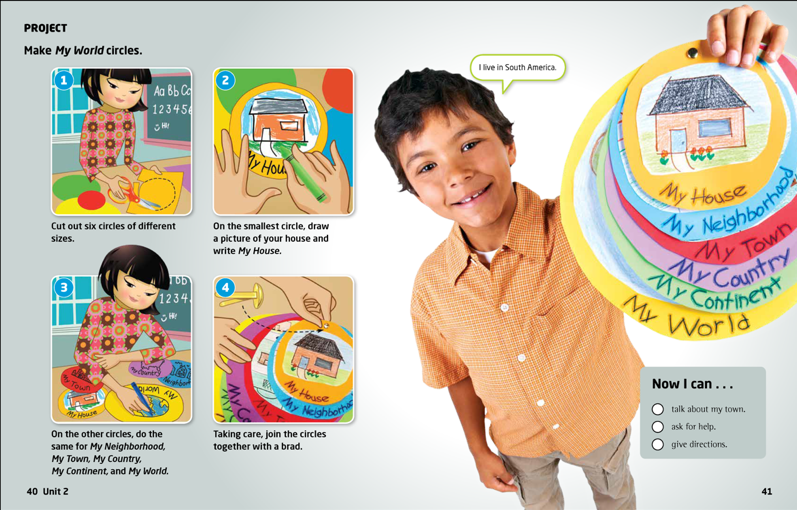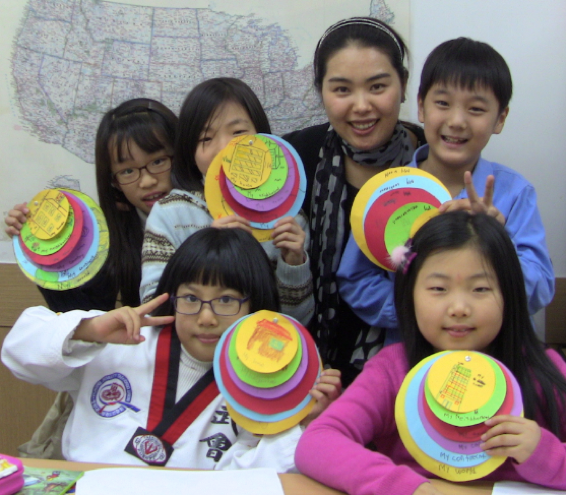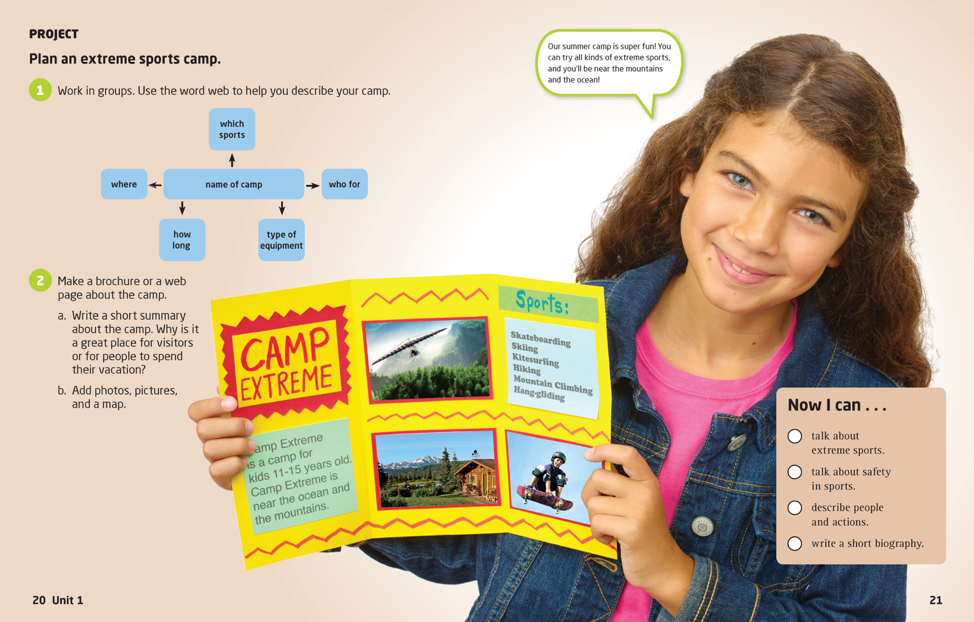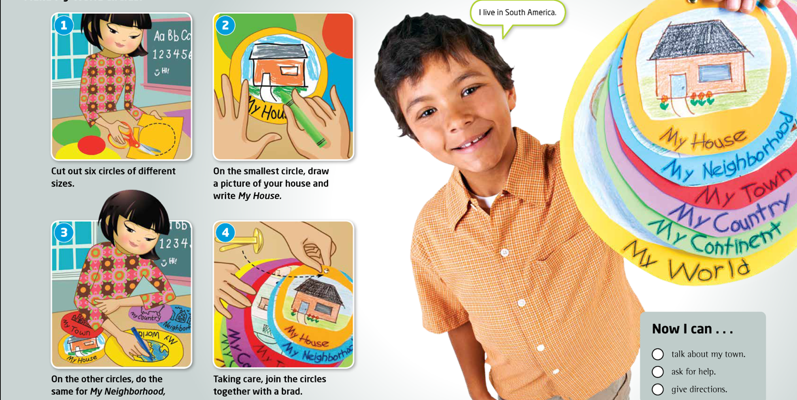Project work can be the perfect multisensory learning experience to give students the opportunity to make things with their own hands and experience the language and content in a meaningful context. Children are active learners and learn best through concrete tasks and hands-on activities. They learn by doing and will understand and remember both language and content better if they have experienced it through all their senses.
Why use projects?
Many teachers will tell you: projects are challenging to use! They require extra classroom time, extra materials, and extra preparation. However, many teachers will also tell you that the benefits far outweigh the challenges. Some benefits are:
- Students can practice using new language in a meaningful context.
- Students get a chance to relate language and content to their lives.
- Students can engage in real world communication.
- Students can practice important 21st century skills, e.g., the 4Cs: communication, collaboration, creativity, and critical thinking skills.
After students learn new language, they need to practice using it and apply it to real and authentic contexts (Shin & Crandall, 2014). Projects are a perfect way to apply language in new and meaningful contexts.
Three tips for success with projects
Here are three simple tips to help you meet with success when using projects with young learners.
TIP #1: Give young learners step-by-step instructions in multiple ways
It is important to break the project down into smaller achievable steps. It will help your young learners organize their work and be more successful. Be sure to give your young learners step-by-step instructions. For the best results, give your young learners instructions through multiple ways: written, spoken, and visual instructions. If some students cannot understand your oral instructions, they can rely on the visual cues to help them complete the project. This will help your young learners succeed. See the My World Circles project page below with four steps that include illustrations in addition to written text (Shin & Crandall, 2020).

TIP #2: Give students a model of the final product
Be sure you show your students what the final product looks like. If they understand your expectations, they can achieve it. The My World Circles project page includes a child with his project (Shin & Crandall, 2020). As the teacher, you should also demonstrate each step one by one and make your own project as a model for them. If you make your own project with enthusiasm, they will too! Then, your students will have a language model and a role model to follow.

TIP #3: Give students a chance to share their work
Always plan enough time in your lesson for students to share their work. If they know they will have a chance to share their project with others, it will motivate them. Sharing their project gives students a purpose for the work they do. Even more important for the learning process, sharing their project will provide students a chance to practice communicating in English. Take a look at this student sharing her project. She is speaking in complete sentences as she presents her project.
BONUS TIP: Never underestimate your young learners!
If your young learners are genuinely interested in the topic and are motivated by the project, they can go beyond your expectations. Projects are an excellent way to differentiate instruction, so you can allow students to produce variations of a project based on their English proficiency level or even based on their particular skills in art, music, science, or multimedia. If you have students who want to be creative and do an adaptation of the project in your textbook or lesson, let them.
Example from the field
Here is a perfect example of students in Greece who were inspired by project work. The original project was designed for children in grade 6 and is part of a unit about extreme sports, such as skiing, kitesurfing, hang-gliding, and motorcross, to name a few. In the coursebook, students are encouraged to plan an extreme sports camp.

An English language teacher in Greece, Anastasia Metallinou, found a way to inspire her 12-year-old students to engage in the topic of extreme sports and create a project that included building 21st century skills, such as writing digital text and using video to communicate. Instead of creating a brochure or webpage as the project page suggests, her students planned and created a video about an extreme sport they researched. After I saw this video, I could imagine a class working on an extreme sport camp webpage with small groups or pairs creating videos just like this to post on that webpage. Anastasia explained her students’ work, “The girls found, downloaded and uploaded the photos themselves, did the storyboard, wrote and recorded their text, created all the visuals and added the audio at the end.” As scaffolding, she gave her students a storyboard graphic organizer to fill out in order to plan the video. This is how she guided her students to plan their video step by step.
Storyboard Graphic Organizer – By Anastasia Metallinou
| Scenes | What I see in each scene (Save each image you would like to use in a USB, and state the image’s name) | What I say and hear in each scene | What I write in each scene |
| 1 | |||
| 2 | |||
| 3 | |||
| 4 | |||
| 5 | |||
| 6 | |||
| 7 |
Here is the final product: a humorous and engaging video about highlining.
As you can see from this video, we should never underestimate our young learners. English learners who are engaged with the topic and inspired by a project can produce work beyond our expectations. In this case, young learners were captivated by the topic of extreme sports and motivated by the use of media. Even with a project that includes step by step instructions, these young learners went above and beyond. Use projects, and let your young learners surprise you!
References
Shin, J. K., & Crandall, J. A. (Eds.). (2020). Our world (Levels Starter-6) (2nd ed.). Boston, MA: National Geographic Learning/Cengage Learning.
Shin, J. K., & Crandall, J. A. (2014). Teaching young learners English: From theory to practice. Boston, MA: National Geographic Learning/Cengage Learning.
Acknowledgements
Special thanks to Anastasia Metallinou from Greece for sending us her students’ video. Anastastia is an English language teacher, dyslexia (SpLDs) specialist and materials writer. She is the co-author of English Sounds Fun, which is a holistic, highly structured and self-contained method, accessible to all learners including those with SpLDs like dyslexia. Anastasia is also a teacher trainer and TESOL Greece SIG coordinator.
For more information about using projects with young learners, watch this webinar Engaging Young Learners with Projects by Jodi Crandall.



Thank for showing both low and high tech. projects. As most of our students visit our school for just sixty minutes a week we have to make the most of every minute. Having different platfroms (Mac vs. Microsoft, version X.etc!) we have had problems with trying to collaborate on software-based projects so have opted for soft/hard cut and paste. For example we recently did a project on litter and recyling where we took photograhs and mounted the pictures in an A4 mini-book. I’d like to send you a pictue/short video. Please could you tell me how to upload?
*Thank you for…
Hi Julian – thanks for your comment and we’re glad you enjoyed Joan’s post. You can email the picture/short video to [email protected] and we’ll get it over to Joan!
Great tips